Japan
Wood Products Prices
Dollar Exchange Rates of 10th
February 2017
Japan Yen 113.20
Reports From Japan
Consumers still putting off durable goods
purchases
Cabinet data from the January consumer confidence
survey is showing a continued improvement with January
confidence coming in at the highest level in over 3 years.
While this is good news it must be remembered that all the
indices are still in the ¡®pessimistic¡¯ range i.e. below 50
(see graph below).
The overall sentiment index rose to 43.2 in January from
43.1 in December but the willingness to buy durable goods
showed no change.
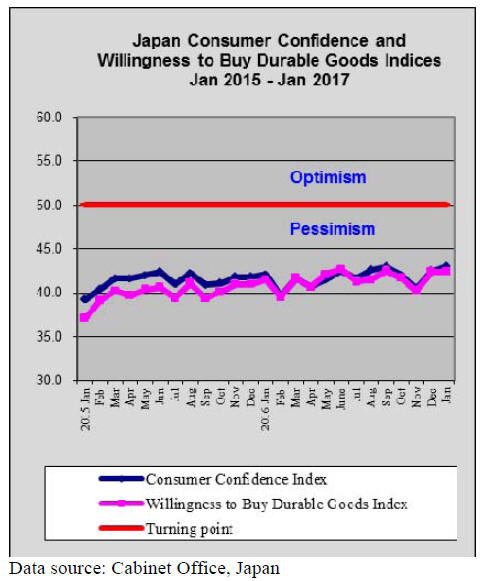
Business confidence at 3 year high
Increased exports boosted by a weaker yen, expansion of
new orders for manufacturers and steady domestic demand
has brightened economic prospects for Japan, at least in
the short term.
Results from the latest business survey compiled by the
Cabinet Office show that manufacturing for export added
most to growth and that the services sector continued to
expand.
Optimism in the private sector has risen even against the
backdrop of uncertainty on where the US economy will be
taken by the new President. The rise in manufacturing
output has also boosted job creation and job growth in
January was at its highest for almost 3 years.
See:
http://www.esri.cao.go.jp/en/stat/di/di-e.html
More talking down the dollar but now by the US
administration
The US President has publically accused Japan of
manipulating the yen/dollar exchange rate, something
fiercely denied in Tokyo. This remark caused the US
dollar to fall to two-month low of yen 112 to the dollar in
early February.
But the ¡®trump effect¡¯ did not last and the yen recovered as
the US President turned his attention to the euro which he
said was grossly undervalued.
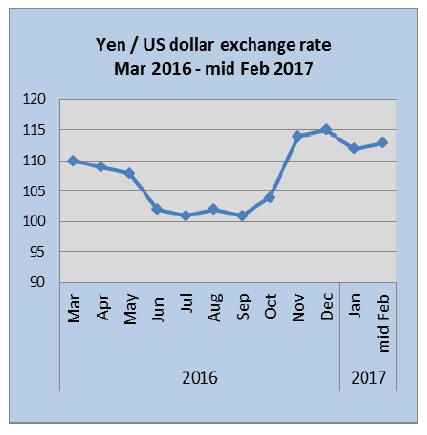
Build-for-rent now a major proportion of housing
starts
2016 housing starts exceeded 960,000 and of that almost
half were homes built-for-rent and was the first time in 8
years that built for rent homes had topped 400,000.
The surge in built-for-rent homes owes as much to
changes in Japan¡¯s inheritance tax structure as the ultralow
interest rates offered by commercial banks.
Local analysts point out that when land owner builds a
property on a plot of land the assessed land value drops
which has the effect of lowering the land value and thus
lowering any inheritance tax liability.
Almost all banks in Japan have campaigns promoting
loans for home building and these are being taken up by
people who see home rentals as a way to put otherwise
stagnant cash to work. The surge in supply.
of apartments is beginning to distort the housing market.
Vacancy rates for apartments in most of the major cities
have increased significantly over the past 12 months
which has put a downward pressure on rents.
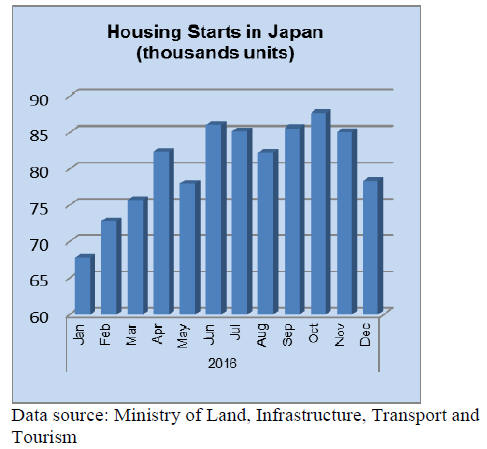
Twin peaks in housing starts
For the first time in 17 years Japan increased the
consumption tax in April 2013 and this caused housing
starts to peak. Home buyers were well prepared and there
was a surge in orders and completions in 2013 as buyers
moved to beat the 3% rise in consumption tax.
The second peak in housing starts was in 2016 and the
driver for this was low interest rates and, as mentioned
above, changes in inheritance tax structures in the country.
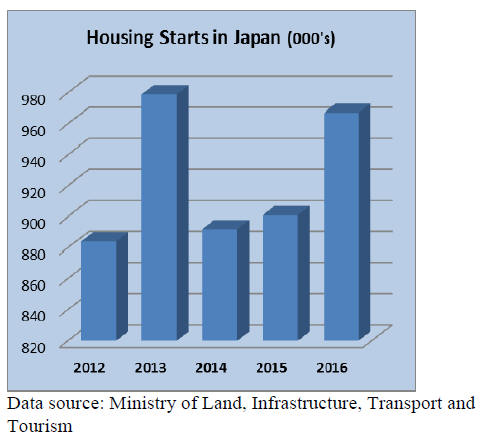
Import round up
Doors
Japan¡¯s fourth quarter 2016 imports of wooden doors (HS
441820) were down 18% compared to the same period in
2105 extending the decline in the first three quarters of
2016 when wooden door imports were around 2% down
year on year.
For 2016 the top four suppliers in order of rank were
China, the Philippines, Indonesia and Malaysia and these
four accounted for over 90% of Japan¡¯s 2016 wooden door
imports.
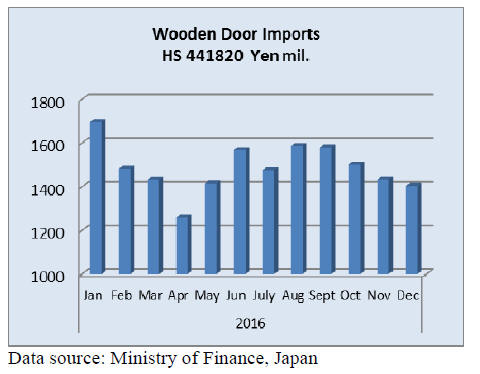
Windows
In the first three quarters of 2016 wooden window imports
were down around 7% compared to the same time in 2015
but the decline slowed in the fourth quarter where 2016
imports were at around the same level as in 2015.
Wooden window imports in 2016 were down 5% on 2015.
Throughout the year shippers in China and the Philippines
dominated Japan¡¯s imports of wooden windows with
shipments in 2016 from these two suppliers accounting for
around 80% of total wooden window imports with most of
the balance being shipped from the US.
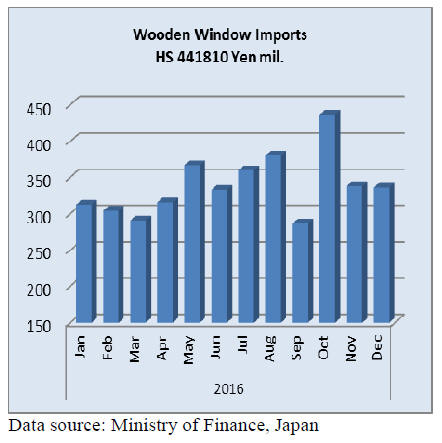
Assembled flooring
Three categories of assembled flooring are included in the data
presented below, HS 441871, 72 and 79.
Despite the significant upward trend in imports of assembled
wooden flooring, overall, 2016 imports were only marginally
higher than in 2015. In November and December there was a
sharp rise in imports of assembled flooring with most of the
growth due to shipments from the main suppliers, China and
Thailand. For the year as a whole shipments of HS441872
accounted for the bulk of imports followed by HS 441879).

Plywood
The figure below shows the trend in imports of 4
categories of plywood, HS 441210/31/32 and 39.
Throughout 2016, as was the case in 2015, almost 90% of
Japan¡¯s plywood imports are from Malaysia, Indonesia
and China.
Plywood imports in 2016 were down 3.5% compared to
2015. Shipments from China fell 20% in 2016 and
shipments from Malaysia were also down (-9%) year on
year. However, plywood imports from Indonesia bucked
the downward trend rising 6%.

Trade news from the Japan Lumber Reports (JLR)
For the JLR report please see:
http://www.nmokuzai.
com/modules/general/index.php?id=7
EPA negotiations with EU
Negotiations on EPA with EU has started but so far there
is no agreement reached. The negotiations are aiming to
open up the markets and to abolish duties on trade
between EU and Japan. Like TPP, all kinds of wood
products like lamina, laminated lumber, SPF lumber, OSB,
melamine board and flooring are subject of negotiations.
At this point, it is uncertain if all the duties are removed
but the most likely scenario is to reach an agreement by
the end of February if both sides wish to conclude early
since many EU countries will have elections after March.
Laminated lumber is the most concerned item as the
volume of European lumber import in 2015 was 2,384,000
cbms, the top among other imports from other sources.
Also total structural laminated lumber import in 2015 was
705,200 cbms, which includes imports from China and the
U.S.A. Domestic production of this item was 1,346,600
cbms. European products are the largest competition with
domestic products.
Import duty on lumber is 4.8% and laminated lumber
3.9%. If these duties are removed totally, market prices
would drop as the import cost is down. The largest factors
of price fluctuation are exchange rate and supply and
demand balance. Pressure on prices gets larger if the
supply increases.
There is possibility that the European suppliers reduce the
export prices to expand market share in Japan. If this
occurs, domestic laminated lumber and solid wood lumber
would face severe price competition.
During process of the negotiation, some information is
reported that Japan would allow same degree of TPP
standard.
Large laminated lumber manufacturer says that there is not
enough information yet so laminated lumber
manufacturers have very little interest but if it would
become the same as TPP, there will be large confusion in
the industry including domestic lumber industry.
In TPP, duty on laminated lumber is totally eliminated to
zero from present 3.9%, which reduces the price of
imported laminated lumber by 2,000 yen per cbm. This
would increase import of laminated lumber but lamina
prices will be reduced step by step so domestic
manufacturers¡¯ cost remains high so imported products
have advantage in prices against domestic laminated
lumber.
There are increasing domestic laminated lumber with
cedar, cypress and larch lamina but they face tough price
competition with the import products. In supply regions,
there is no move to increase production for Japan yet
without any final agreement but some are reviewing
supply structure for Japan market.¡¯
Risk of yen fluctuations drives down size of orders for
imported plywood
Supply tightness continues on both domestic and imported
plywood. Active orders from precutting plants on
domestic softwood plywood continues even after the New
Year holidays.
Meantime, future orders on imported plywood are absolute
minimum volume because there is possibility of drastic
fluctuation of exchange rate, depending on policy the new
president Tramp (Trump) takes. Present market is affected
by recent depreciation of the yen so the importers are
asking higher prices.
Looking at trend of the market, some users of concrete
forming panels try to procure low price items so the
movement is getting active compared to last December but
actually there is very little available as the inventories are
down close to the bottom so the importers and wholesalers
are waiting for next arrivals.
Actually the importers purchase minimum volume with
back to back contracts with the customers so there is no
surplus in the market. Accordingly, supply and demand
are balanced. Since future exchange rate is hard to foresee.
The importers are not able to make aggressive purchases.
Domestic softwood plywood production in last December
was 238,700 cbms, 3.0% more than the same month in
2015 and total yearly production was 2,897,200 cbms,
11.9% more than 2015. This the highest in last five years.
Monthly average production in the fourth quarter last year
was 247 M cbms while the shipment was 249,800 cbms so
the shipment continues to exceed the production. Total
year shipment was 2,939,000 cbms, 9.1% more than 2015.
The inventories were have been extreme low of less than
100 M cbms since last August so plywood mills ship out
as soon as produced with practically zero inventory.
December production of structural softwood plywood inn
December was 229,800 cbms, 8.7% more than December
last year and total year production was 2,786,500 cbms.
December shipment was higher than production at 238 M
cbms and the inventory was 77,200 cbms, 900 cbms less
than November. Some plywood manufacturers increase
the sales prices slightly since January because of higher
log prices and adhesive prices and they are considering to
make another hike during February.
For more see Japan Lumber Reports Feb. 3, 2017 No. 691

|